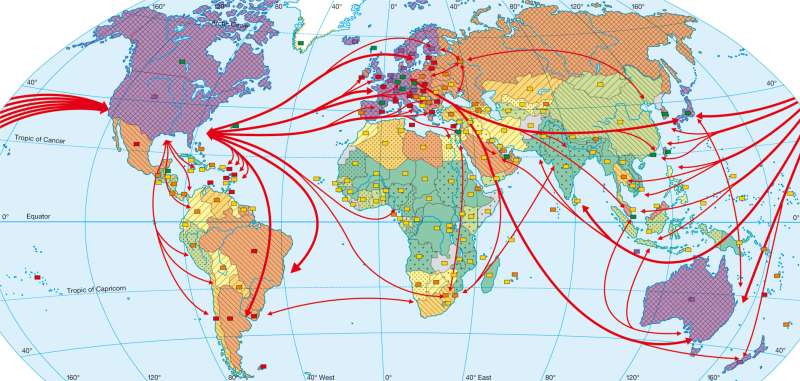Transportation and communication
The world - Globalization
978-3-14-100790-9 | Page 194 | Ill. 2

Information
The map shows that the countries with a high density of automobiles and telephones are often at the same time also those with a high density of permanent internet connections. The countries with particularly good transport and communications coverage are mainly the economically powerful industrialized nations with a high share of world trade as well as a number of industrializing countries in which, although also with regional differences, high densities have also been reached. There is a similar parallel where the indicators shown have low values, which mainly occurs in countries with a low level of development.Automobile density is above all a measure of the individual welfare of a society. This is significant in the industrialized countries with the highest level of development. Automobile density also acts as an indicator of a country's transport coverage. It is easier to collect statistically than the density, length and quality of road and rail connections.
Telephone density is one of the indicators of a modern, high-capacity communications technology in an economy facing globalization. As a general rule, the higher the telephone density, the faster and cheaper is the communication. This applies even more to the expanding communication technologies of the internet, i.e. digital transmission via broadband networks such as DSL. The development of the necessary technical infrastructure requires high investments, which are easier for the developed countries — or the financially powerful firms that make profit-oriented investments in these countries — to afford than the financially weaker developing countries.
Host Density and Data Streams
Worldwide data streams are heavily oriented towards the homeland of the internet, the USA. No other country can compete with it. The USA contains the majority of root servers, which stand at the top of the Domain Name Servers (DNS). DNS translate the user's query, e.g. from "www.diercke.de" they ascertain a unique numerical server address, the IP address.
The servers act as internet nodes and as interchange points for internet data traffic. Backbones are high-speed broadband connections between the nodes of a network. For example, the speed between the Japanese and US nodes of the company NTT's network increased from 45 Mbps in 1997 to 100 Gbps in 2007.
A comparison within Europe shows that the Scandinavian countries, for example, have a significantly higher intensity of internet usage than Germany. Since the data for host density is presented in relative terms, Germany appears on the map at the same level as Greenland!
The dimensions of the digital gap are clear from the example of Africa. Until now, with the exception of South Africa, this continent has been scarcely or not at all integrated into international data exchange. Thus it is a fact that in the field of access to information, which counts today as the vital key to technological and economic progress, the gap between the developing countries and the industrialized nations is growing ever wider. It remains to be seen how far the 100-dollar laptops designed especially for industrializing and developing countries, the realization of which is being promoted by the UN Development Programme, can change this situation.
K. Heyden; Ü: J. Attfield




